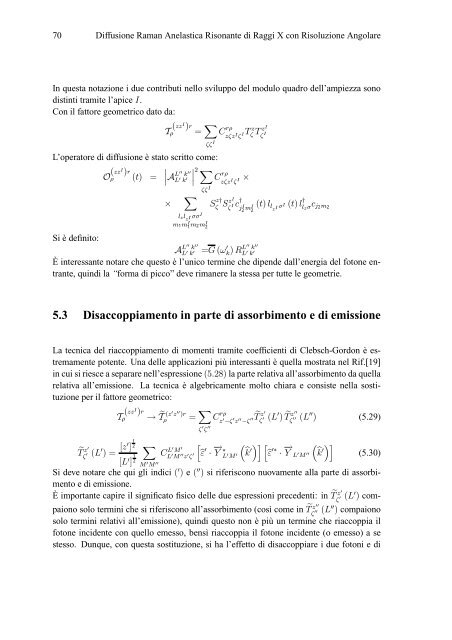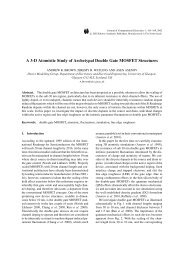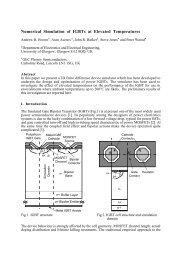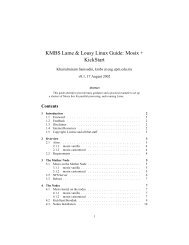Diffusione Raman Anelastica Risonante di Raggi X con Risoluzione ...
Diffusione Raman Anelastica Risonante di Raggi X con Risoluzione ...
Diffusione Raman Anelastica Risonante di Raggi X con Risoluzione ...
Create successful ePaper yourself
Turn your PDF publications into a flip-book with our unique Google optimized e-Paper software.
70 <strong>Diffusione</strong> <strong>Raman</strong> <strong>Anelastica</strong> <strong>Risonante</strong> <strong>di</strong> <strong>Raggi</strong> X <strong>con</strong> <strong>Risoluzione</strong> Angolare<br />
In questa notazione i due <strong>con</strong>tributi nello sviluppo del modulo quadro dell’ampiezza sono<br />
<strong>di</strong>stinti tramite l’apice I.<br />
Con il fattore geometrico dato da:<br />
= X<br />
T (zzI )r<br />
ρ<br />
ζζ I<br />
L’operatore <strong>di</strong> <strong>di</strong>ffusione è stato scritto come:<br />
O (zzI )r<br />
ρ (t) =<br />
¯<br />
¯A L00 k00 L0 k0 ¯2<br />
¯ X<br />
¯<br />
ζζI × X<br />
S z†<br />
lzlzI σσI m1mI 1m2mI 2<br />
C rρ<br />
zζzI ζIT z ζ T zI<br />
ζI C rρ<br />
zζz I ζ I ×<br />
ζ SzI<br />
I c†<br />
ζ<br />
j I 2 mI 2<br />
(t) llzI σI (t) l†<br />
lzσcj2m2 Si è definito:<br />
A L00 k00 L0 k0 =G (ω0k) R L00 k00 L0 k0 È interessante notare che questo è l’unico termine che <strong>di</strong>pende dall’energia del fotone entrante,<br />
quin<strong>di</strong> la “forma <strong>di</strong> picco” deve rimanere la stessa per tutte le geometrie.<br />
5.3 Disaccoppiamento in parte <strong>di</strong> assorbimento e <strong>di</strong> emissione<br />
La tecnica del riaccoppiamento <strong>di</strong> momenti tramite coefficienti <strong>di</strong> Clebsch-Gordon è estremamente<br />
potente. Una delle applicazioni più interessanti è quella mostrata nel Rif.[19]<br />
in cui si riesce a separare nell’espressione (5.28) la parte relativa all’assorbimento da quella<br />
relativa all’emissione. La tecnica è algebricamente molto chiara e <strong>con</strong>siste nella sostituzione<br />
per il fattore geometrico:<br />
= X<br />
T (zzI )r<br />
ρ<br />
ζ 0 (L0 )= [z0 ] 1<br />
2<br />
eT z0<br />
[L 0 ] 1<br />
2<br />
→ eT (z0 z 00 )r<br />
ρ<br />
X<br />
M 0 M 00<br />
ζ 0 ζ 00<br />
C rρ<br />
z0−ζ 0z00 eT<br />
z0<br />
00 −ζ ζ0 (L0 ) eT z00<br />
ζ00 (L00 ) (5.29)<br />
C L0M 0<br />
L0M 00z0ζ 0<br />
h<br />
bε 0 · −→ Y ∗ L0M 0<br />
³ ´i h<br />
bk 0<br />
bε 0∗ · −→ Y L0M 00<br />
³ ´i<br />
bk 0<br />
(5.30)<br />
Si deve notare che qui gli in<strong>di</strong>ci ( 0 ) e ( 00 ) si riferis<strong>con</strong>o nuovamente alla parte <strong>di</strong> assorbimento<br />
e <strong>di</strong> emissione.<br />
È importante capire il significato fisico delle due espressioni precedenti: in eT z0<br />
ζ 0 (L0 ) com-<br />
paiono solo termini che si riferis<strong>con</strong>o all’assorbimento (così come in eT z00<br />
ζ 00 (L00 ) compaiono<br />
solo termini relativi all’emissione), quin<strong>di</strong> questo non è più un termine che riaccoppia il<br />
fotone incidente <strong>con</strong> quello emesso, bensì riaccoppia il fotone incidente (o emesso) a se<br />
stesso. Dunque, <strong>con</strong> questa sostituzione, si ha l’effetto <strong>di</strong> <strong>di</strong>saccoppiare i due fotoni e <strong>di</strong>





